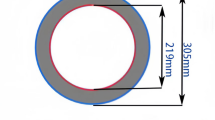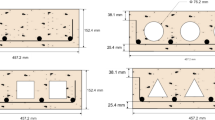Abstract
The restrained ring test, which is recommended by AASHTO and ASTM, has been used for assessing the potential of early-age cracking of concrete and other cement-based materials. Recently, a novel elliptical ring test method has been proposed to replace the circular ring test method for the purpose of shortening ring test duration and observing crack initiation and propagation more conveniently. In order to explore the mechanism of this novel test method, a numerical model is developed to analyze crack initiation and propagation process in restrained concrete rings, in which the effect of concrete shrinkage is simulated by a fictitious temperature drop applied on concrete causing the same strain as that induced by shrinkage. First, an elastic analysis is conducted to obtain the circumferential stress contour of a concrete ring subject to restrained shrinkage. Combined with the fictitious crack model, a fracture mechanics method is introduced to determine crack initiation and propagation, in which crack resistance caused by cohesive force acting on fracture process zone is considered. Finite element analysis is carried out to simulate the evolution of stress intensity factor in restrained concrete rings subject to circumferential drying. Cracking age and position of a series of circular/elliptical concrete rings are obtained from numerical analyses which agree reasonably well with experimental results. It is found that the sudden drop of steel strain observed in the restrained ring test represents the onset of unstable crack propagation rather than crack initiation. The results given by the AASHTO/ASTM restrained ring test actually reflects the response of a concrete ring as a structure to external stimulation, in this case restrained concrete shrinkage.










Similar content being viewed by others

Abbreviations
- a :
-
Crack length
- A :
-
Exposed surface area of a concrete element
- d :
-
Steel ring thickness
- E :
-
Elastic modulus of concrete
- f c :
-
Uniaxial compressive strength
- f t :
-
Splitting tensile strength of concrete
- G F :
-
Fracture energy
- \(K_{\text{I}}^{\text{S}}\) :
-
Stress intensity factor caused by applied load
- \(K_{\text{I}}^{\sigma }\) :
-
Stress intensity factor caused by cohesive force
- R 0 :
-
Inner diameter of circular concrete ring
- R 1 :
-
Major semi-axes of inner circumference of elliptical concrete ring
- R 2 :
-
Minor semi-axes of inner circumference of elliptical concrete ring
- t :
-
Age of concrete
- V :
-
Volume of a concrete element
- w :
-
Crack opening displacement
- w 0 :
-
Stress-free crack opening displacement
- w s :
-
Displacement corresponding to the break point in bilinear σ–w relationship
- Δa :
-
Crack growth length
- ΔP :
-
Load incensement
- σ :
-
Cohesive stress
- σ s :
-
Stress corresponding to the break point in bilinear σ–w relationship
References
Carlson RW, Reading TJ (1988) Model study of shrinkage cracking in concrete building walls. ACI Struct J 85(4):395–404
Gilbert RI (1992) Shrinkage cracking in fully restrained concrete members. ACI Struct J 89(2):141–149
Almudaiheem JA, Hansen W (1987) Effect of specimen size and shape on drying shrinkage of concrete. ACI Mater J 84(2):130–135
Malhotra VM, Zoldners NG (1967) Comparison of ring-tensile strength of concrete with compressive flexural and splitting-tensile strengths. J Mater 2(1):160
Swamy RN, Stavrides H (1979) Influence of fiber reinforcement on restrained shrinkage and cracking. ACI J Proc 76(3):443–460
Branch J, Rawling A, Hannant DJ, Mulheron M (2002) The effects of fibres on the plastic shrinkage cracking of high strength concrete. Mater Struct 35(3):189–194
See HT, Attiogbe EK, Miltenberger MA (2003) Shrinkage cracking characteristics of concrete using ring specimens. ACI Mater J 100(3):239–245
Mokarem DW, Weyers RE, Lane DS (2005) Development of a shrinkage performance specifications and prediction model analysis for supplemental cementitious material concrete mixtures. Cement Concrete Res 35(5):918–925
Passuello A, Moriconi G, Shah SP (2009) Cracking behavior of concrete with shrinkage reducing admixtures and PVA fibers. Cement Concrete Comp 31(10):699–704
Tongaroonsri S, Tangtermsirikul S (2009) Effect of mineral admixtures and curing periods on shrinkage and cracking age under restrained condition. Constr Build Mater 23(2):1050–1056
Weiss WJ, Yang W, Shah SP (2000) Influence of specimen size/geometry on shrinkage cracking of rings. J Eng Mech 126(1):93–101
Moon JH, Weiss J (2006) Estimating residual stress in the restrained ring test under circumferential drying. Cement Concrete Compos 28(5):486–496
Hossain AB, Weiss J (2006) The role of specimen geometry and boundary conditions on stress development and cracking in the restrained ring test. Cement Concrete Res 36(1):189–199
Moon JH, Rajabipour F, Pease B, Weiss J (2006) Quantifying the influence of specimen geometry on the results of the restrained ring test. J ASTM Int 3(8):1–14
He Z, Zhou X, Li Z (2004) New experimental method for studying early-age cracking of cement-based materials. ACI Mater J 101(1):1–7
He Z, Li Z (2005) Influence of alkali on restrained shrinkage behavior of cement-based materials. Cement Concrete Res 35(3):457–463
He Z, Li ZJ, Chen MZ, Liang WQ (2006) Properties of shrinkage-reducing admixture-modified pastes and mortar. Mater Struct 39(4):445–453
Ma BG, Wang XG, Liang WQ, Li XG, He Z (2007) Study on early-age cracking of cement-based materials with superplasticizers. Constr Build Mater 21(11):2017–2022
Gao Y, Tang S, Zhang H, Liu H (2013) Study on early autogenous shrinkage and crack resistance of fly ash high-strength lightweight aggregate concrete. Mag Concrete Res 65(15):906–913
Pour-Ghaz M, Poursaee A, Spragg R, Weiss J (2011) Experimental methods to detect and quantify damage in restrained concrete ring specimens. J Adv Concrete Technol 9(3):251–260
Yoo DY, Park JJ, Kim SW, Yoon YS (2014) Influence of ring size on the restrained shrinkage behavior of ultra high performance fiber reinforced concrete. Mater Struct 47(7):1161–1174
Zou D, Weiss J (2014) Early age cracking behavior of internally cured mortar restrained by dual rings with different thickness. Constr Build Mater 66(9):146–153
Shah SP, Sheng OC, Marikunte S, Yang W, Emilie B-G (1998) A method to predict shrinkage cracking of concrete. ACI Mater J 95(4):339–346
Turcry P, Loukili A, Haidar K, Pijaudier-Cabot G, Belarbi A (2006) Cracking tendency of self-compacting concrete subjected to restrained shrinkage: experimental study and modeling. J Mater Civil Eng 18(1):46–54
Ouyang C, Mobasher B, Shah SP (1990) An R-curve approach for fracture of quasi-brittle materials. Eng Fract Mech 37(4):901–913
Ouyang C, Shah SP (1991) Geometry-dependent R-curve for quasi-brittle materials. J Am Ceram Soc 74(11):2831–2836
Weiss WJ, Yang W, Shah SP (1998) Shrinkage cracking of restrained concrete slabs. J Eng Mech ASCE 124(7):765–774
Weiss J (1999) Prediction of early-age shrinkage cracking in concrete. Northwestern University
Dong W, Zhou X, Wu Z (2014) A fracture mechanics-based method for prediction of cracking of circular and elliptical concrete rings under restrained shrinkage. Eng Fract Mech 131(12):687–701
Zhou X, Dong W, Oladiran O (2014) Assessment of restrained shrinkage cracking of concrete using elliptical ring specimens: experimental and numerical. J Mater Civil Eng 26(12):871–878
Hossain AB, Weiss J (2004) Assessing residual stress development and stress relaxation in restrained concrete ring specimens. Cement Concrete Compos 26(5):531–540
Shah HR, Weiss J (2006) Quantifying shrinkage cracking in fiber reinforced concrete using the ring test. Mater Struct 39(9):887–899
Hillerborg A, Modéer M, Petersson PE (1976) Analysis of crack formation and crack growth in concrete by means of fracture mechanics and finite elements. Cement Concrete Res 6(6):773–781
Radlinska A, Bucher B, Weiss J (2008) Comments on the interpretation of results from the restrained ring test. J ASTM Int 5(10):1–12
Schlitter JL, Senter AH, Bentz DP, Nantung T, Weiss WJ (2010) A dual concentric ring test for evaluating residual stress development due to restrained volume change. J ASTM Int 7(9):1–13
Schlitter JL, Barrett T, Weiss J Restrained shrinkage behavior due to combined autogenous and thermal effects in mortars containing super absorbent polymer (SAP). In: Jensen OM, Hasholt OM, Laustsen S (eds) International RILEM Conference on Use of Superabsorbent Polymers and Other New Additives in Concrete 2010. RILEM Publications SARL, pp 233–242
Schlitter JL, Bentz DP, Weiss WJ (2013) Quantifying stress development and remaining stress capacity in restrained. Internally cured mortars. ACI Mater J 110(1):3–11
Petersson PE (1981) Crack growth and development of fracture zones in plain concrete and similar materials. Division of Building Materials, Lund Institute of Technology, Report TVBM-1006, Sweden, 1981
Moës N, Belytschko T (2002) Extended finite element method for cohesive crack growth. Eng Fract Mech 69(7):813–833
Ooi ET, Yang ZJ (2011) Modelling crack propagation in reinforced concrete using a hybrid finite element-scaled boundary finite element method. Eng Fract Mech 78(2):252–273
Yang ZJ, Deeks AJ (2007) Fully-automatic modelling of cohesive crack growth using a finite element-scaled boundary finite element coupled method. Eng Fract Mech 74(16):2547–2573
Ooi ET, Yang ZJ (2010) A hybrid finite element-scaled boundary finite element method for crack propagation modelling. Comput Method Appl M 199(17–20):1178–1192
Ooi ET, Yang ZJ (2009) Modelling multiple cohesive crack propagation using a finite element-scaled boundary finite element coupled method. Eng Anal Bound Elem 33(7):915–929
Acknowledgments
The financial support from the National Natural Science Foundation of China under the grants of NSFC 51478083 & 51421064, Engineering and Physical Sciences Research Council under the grant of EP/I031952/1, and the National Basic Research Program of China (973 Program, Grant No. 2015CB057703) is gratefully acknowledged.
Author information
Authors and Affiliations
Corresponding author
Rights and permissions
About this article
Cite this article
Dong, W., Zhou, X., Wu, Z. et al. Investigating crack initiation and propagation of concrete in restrained shrinkage circular/elliptical ring test. Mater Struct 50, 73 (2017). https://doi.org/10.1617/s11527-016-0942-1
Received:
Accepted:
Published:
DOI: https://doi.org/10.1617/s11527-016-0942-1



